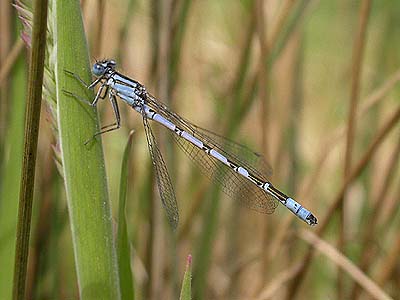

| Dragonfly watching at Eakring Flash | ||
| ... | ||
 |
The current list at the
end of 2017 totals 15 species. All have now occurred at
Eakring Flash including the Large Red Damselfly, which
has now begun to colonise that site, being previously
confined to just one other site in the area. The formation of Eakring Flash has been instrumental in the encouragement of both colonisation of several new Odonata species, and the spread of existing populations formerly restricted to the Eakring Meadows area and in particular the Penny Pasture Common pool. Most species are generally tied to these two sites. The larger Hawkers and the Darters however, can be met with virtually anywhere, even well away from the nearest water. |
|
| ... | ||
| One of the commonest is
the Black-tailed Skimmer, a species which has been very
quick to establish itself here and recent years have seen
up to 15 adults counted on the wing, making it perhaps
the easiest of the larger dragonflies to see. They tend
to favour the shallower water around the edge of the
flash, most notably, the southern end. The Hawkers are well represented here, the Brown Hawker being the most frequently encountered species, until Migrant Hawkers out-number them later in the year. A search along The Beck, is also likely to reveal one of the most spectacular species found here, the Emperor Dragonfly. The strikingly blue and green males, often patrolling the slower-moving parts around the footbridge at the northern end. This area is also guaranteed to produce the delightful Banded Demoiselle. A recent coloniser (2000) has been the Emerald Damselfly. It is a species that can be easily missed here, adults particularly favouring long grass and rank vegetation at the waterside. Numbers are increasing and the coming years should see it becoming a much more common sight. When to visit Pick a bright, sunny day (early afternoon being best) Dragonflies are on the wing from around late May until late October and into November if the weather continues mild. |